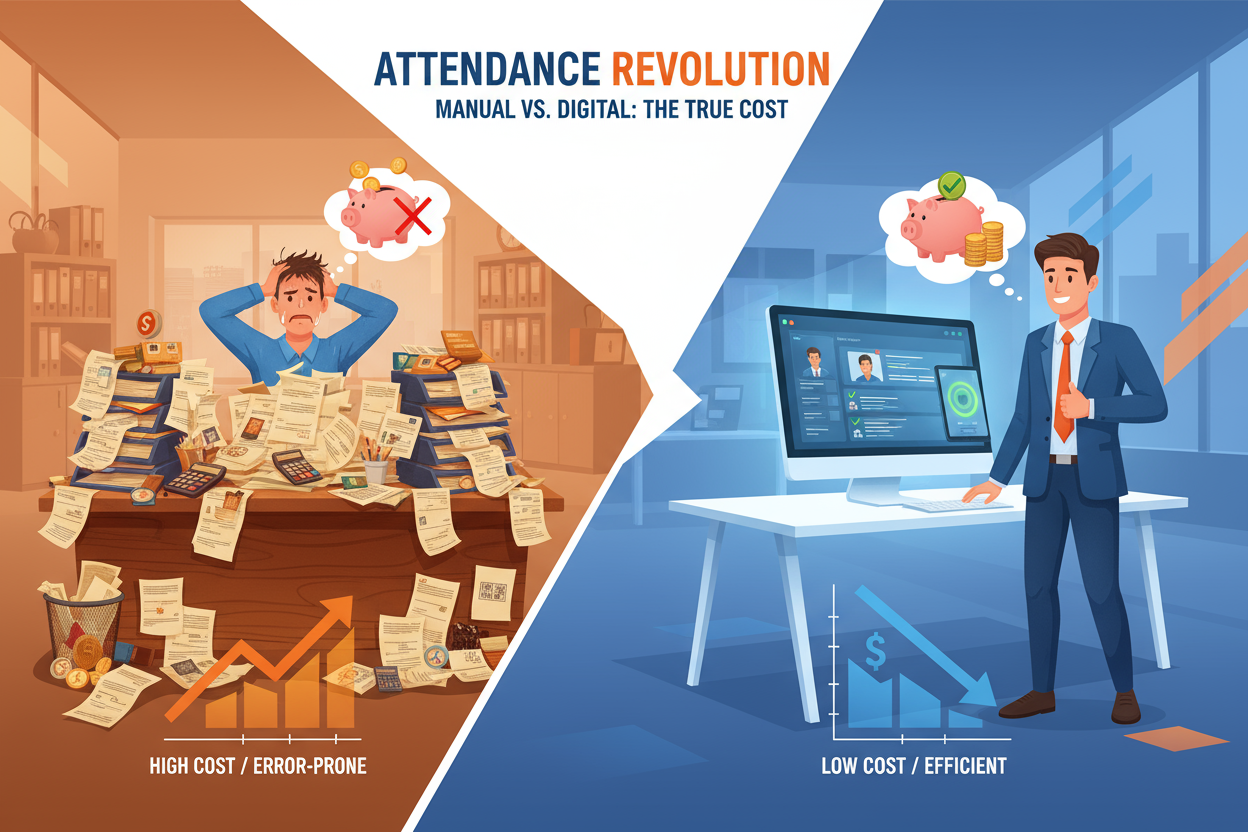Your basket is empty
Already have an account? Log in to check out faster.
Already have an account? Log in to check out faster.

Most companies believe that using manual attendance sheets or punch cards saves money. After all, it doesn’t require fancy software or complex integrations. But what seems simple on the surface can actually cost your organisation much more in the long run — in time, accuracy, compliance, and employee morale.
In 2026, when technology allows real-time tracking and automation, relying on outdated attendance systems is like using a typewriter in a digital office. Let’s explore the hidden costs behind manual attendance tracking — and how switching to Gallery HR can help you avoid them entirely.
One of the most immediate costs of manual systems is the time wasted on paperwork and data entry. HR officers spend hours collecting, verifying, and calculating attendance records every month.
Think about it: if your HR team spends even 3–4 hours a week just validating attendance logs, that’s over 200 hours per year lost to manual work — time that could be used for training, development, or employee engagement.
With Gallery HR’s smart attendance module, employees can clock in via biometric, mobile, or web access. The data syncs automatically, giving HR instant visibility without manual compilation. This not only saves time but also ensures accuracy from the moment an employee signs in.
Example: A garment factory in Kandy employing 120 workers used to process attendance manually. After adopting Gallery HR, the HR team cut their weekly admin time by 75% — freeing them to focus on workforce planning and skills training instead.

When attendance is tracked manually, even a small mistake can snowball into a major issue during payroll. A missed check-in, a misread signature, or a forgotten overtime entry can lead to incorrect salary calculations.
These errors don’t just frustrate employees — they also cost the company money through overpayments, underpayments, and lost trust. Correcting these mistakes often takes days, creating unnecessary tension and administrative burden.
Gallery HR automatically integrates attendance with payroll, ensuring every late entry, overtime hour, or leave day is accurately reflected. The system does the math, removing the guesswork — and the errors — from the equation.
In Sri Lanka, companies are required to maintain accurate employee attendance and working-hour records for labour compliance, EPF/ETF calculations, and audits. Manual systems make it difficult to produce reliable, time-stamped data when required.
A misplaced file or incomplete log can lead to compliance violations and, in worst cases, financial penalties. With digital systems like Gallery HR, every entry is automatically recorded, timestamped, and securely stored — giving you an auditable trail at any moment.
Example: A logistics company in Colombo faced a compliance audit in 2024 and struggled to produce attendance records for the past year. After switching to Gallery HR, their audit preparation time dropped from weeks to minutes, since every report was accessible with a single click.

Manual attendance systems provide information only after the fact. Managers often find out about absenteeism, late arrivals, or shift issues after the day ends — too late to respond effectively.
With Gallery HR’s real-time dashboard, HR teams and department heads can see who’s in, who’s late, and who’s absent — live. This allows faster decisions, better scheduling, and improved workforce management.
Imagine a construction site where half the workers are delayed due to transport issues. With real-time tracking, HR can quickly adjust schedules, call in replacements, or reschedule deliveries. Without it, productivity drops and costs increase.
The ability to act instantly — not after the fact — is one of the biggest competitive advantages digital HR systems provide.

It’s easy to overlook the emotional cost of manual attendance systems. When employees feel that attendance and payroll are handled unfairly or inconsistently, morale drops. They begin to question management’s transparency and accuracy.
Manual systems often create disputes — “I signed in on time,” “My overtime wasn’t counted,” “My leave wasn’t approved.” These recurring conflicts waste time, damage relationships, and increase turnover risk.
Gallery HR solves this by giving employees self-service access to their attendance records, leave balances, and approvals. Transparency builds trust, and trust reduces turnover — saving far more than any “cost-saving” manual system ever could.
Avoiding these hidden expenses is simple: embrace automation. By moving to an integrated HR system like Gallery HR, you can eliminate repetitive tasks, improve accuracy, and keep compliance stress-free.
Transitioning doesn’t mean disrupting your current process — Gallery HR’s modular system adapts to your organisation’s size and workflow. Whether you manage 20 employees or 2,000, the shift from manual to digital can happen smoothly, with immediate ROI in efficiency and morale.
Manual attendance systems may seem cheaper at first glance, but they drain your organisation’s most valuable resources — time, accuracy, and trust. The hidden costs pile up silently until they become impossible to ignore.
By digitising attendance management with Gallery HR, you unlock real-time visibility, error-free payroll, compliance peace of mind, and a better employee experience.
In 2026, success isn’t just about working harder — it’s about working smarter. And the smartest move your business can make today is to leave manual HR systems in the past.
0 comments